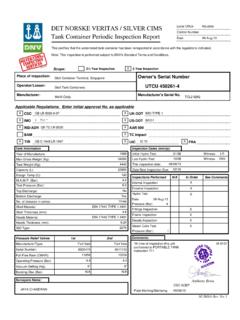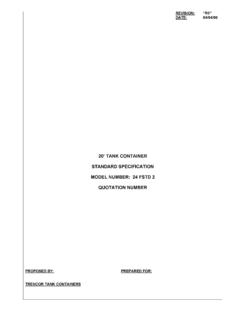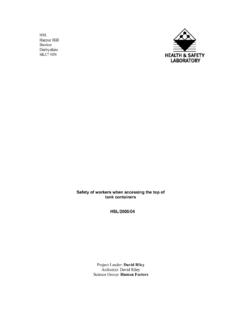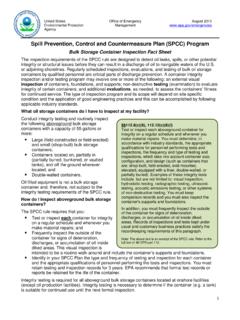Transcription of Electronic Code of Federal Regulations - Silver …
1 17-11-2009 Electronic code of Federal Regulations : Subpart G Qualification and Maintenance of Portable tanks top Source: 66 FR 33453, June 21, 2001, unless otherwise noted. Applicability. top This subpart prescribes requirements, in addition to those contained in parts 107, 171, 172, 173, and 178 of this subchapter, applicable to any person responsible for the continuing qualification, maintenance or periodic retesting of a portable tank. Qualification of portable tanks . top (a) Each portable tank used for the transportation of hazardous materials must be an authorized packaging. (b) To qualify as an authorized packaging, each portable tank must conform to the requirements of this subchapter and the applicable design specification to which the portable tank was constructed.
2 (c) The following portable tanks are authorized for use provided they conform to all applicable safety requirements of this subchapter: 51, 56, 57, 60, IM 101, IM 102 and UN portable tanks . (d) A portable tank that also meets the definition of container in 49 CFR (a)(3) must conform to the requirements in parts 450 through 453 of this title for compliance with Annex II of the Convention for Safe Containers (CSC). (e) Exemption portable tanks based on DOT 51 portable tanks . The owner of a portable tank constructed in accordance with and used under an exemption issued prior to August 31, 1996, which was in conformance with the requirements for Specification DOT 51 portable tanks with the exception of the location of fill and discharge outlets, shall examine the portable tank and its design to determine if it meets the outlet requirements in effect on October 1, 1996.
3 If the owner determines that the portable tank is in compliance with all requirements of the DOT 51 specification, the exemption number stenciled on the portable tank shall be removed and the specification plate (or a plate placed adjacent to the specification plate) shall be durably marked DOT 51 E** (where ** is to be replaced by the exemption number). During the period the portable tank is in service, and for one year thereafter, the owner of the portable tank must retain on file, at its principal place of business, a copy of the last exemption in effect. Requirements for periodic testing, inspection and repair of portable tanks . top (a) A portable tank constructed in accordance with a DOT specification for which a test or inspection specified in this subpart has become due, must be tested or inspected prior to being returned for transportation.
4 (b) Conditions requiring test and inspection of portable tanks . Without regard to any other test or inspection requirements, a Specification or UN portable tank must be tested and inspected in accordance with this section prior to further use if any of the following conditions exist: (1) The portable tank shows evidence of dents, corroded or abraded areas, leakage, or any other condition that might render it unsafe for transportation service. 1/4. 17-11-2009 Electronic code of Federal Regulations : (2) The portable tank has been in an accident and has been damaged to an extent that may adversely affect its ability to retain the hazardous material. (3) The portable tank has been out of hazardous materials transportation service for a period of one year or more.
5 (4) The portable tank has been modified from its original design specification. (5) The portable tank is in an unsafe operating condition based on the existence of probable cause. (c) Schedule for periodic inspections and tests. Each Specification portable tank must be tested and inspected in accordance with the following schedule: (1) Each IM or UN portable tank must be given an initial inspection and test before being placed into service, a periodic inspection and test at least once every 5 years, and an intermediate periodic inspection and test at least every years following the initial inspection and the last 5 year periodic inspection and test. (2) Each Specification 51 portable tank must be given a periodic inspection and test at least once every five years.
6 (3) Each Specification 56 or 57 portable tank must be given a periodic inspection and test at least once every years. (4) Each Specification 60 portable tank must be given a periodic inspection and test at the end of the first 4-year period after the original test; at least once every 2 years thereafter up to a total of 12 years of service; and at least once annually thereafter. Retesting is not required on a rubber-lined tank except before each relining. (d) Intermediate periodic inspection and test. For IM and UN portable tanks the intermediate year periodic inspection and test must include at least an internal and external examination of the portable tank and its fittings taking into account the hazardous materials intended to be transported; a leakage test; and a test of the satisfactory operation of all service equipment.
7 Sheathing, thermal insulation, etc. need only be removed to the extent required for reliable appraisal of the condition of the portable tank. For portable tanks intended for the transportation of a single hazardous material, the internal examination may be waived if it is leakage tested in accordance with the procedures in paragraph (h) of this section prior to each filling, or if approved by the Associate Administrator. Portable tanks used for dedicated transportation of refrigerated liquefied gases that are not fitted with inspection openings are excepted from the internal inspection requirement. (e) Periodic inspection and test. The 5 year periodic inspection and test must include an internal and external examination and, unless excepted, a pressure test as specified in this section.
8 Sheathing, thermal insulation, etc. need only to be removed to the extent required for reliable appraisal of the condition of the portable tank. Except for DOT Specification 56 and 57 portable tanks , reclosing pressure relief devices must be removed from the tank and tested separately unless they can be tested while installed on the portable tank. For portable tanks where the shell and equipment have been pressure-tested separately, after assembly they must be subjected together to a leakage test and effectively tested and inspected for corrosion. Portable tanks used for the transportation of refrigerated, liquefied gases are excepted from the requirement for internal inspection and the hydraulic pressure test during the 5-year periodic inspection and test, if the portable tanks were pressure tested to a minimum test pressure of times the design pressure using an inert gas as prescribed in 16(a) and (b) of this subchapter before putting the portable tank into service initially and after any exceptional inspections and tests specified in paragraph (f) of this section.
9 (f) Exceptional inspection and test. The exceptional inspection and test is necessary when a portable tank shows evidence of damaged or corroded areas, or leakage, or other conditions that indicate a deficiency that could affect the integrity of the portable tank. The extent of the exceptional inspection and test must depend on the amount of damage or deterioration of the portable tank. It must include at least the inspection and a pressure test according to paragraph (e) of this section. Pressure relief devices need not be tested or replaced unless there is reason to believe the relief devices have been affected by the damage or deterioration. 2/4. 17-11-2009 Electronic code of Federal Regulations : (g) Internal and external examination.
10 The internal and external examinations must ensure that: (1) The shell is inspected for pitting, corrosion, or abrasions, dents, distortions, defects in welds or any other conditions, including leakage, that might render the portable tank unsafe for transportation;. (2) The piping, valves, and gaskets are inspected for corroded areas, defects, and other conditions, including leakage, that might render the portable tank unsafe for filling, discharge or transportation;. (3) Devices for tightening manhole covers are operative and there is no leakage at manhole covers or gaskets;. (4) Missing or loose bolts or nuts on any flanged connection or blank flange are replaced or tightened.






